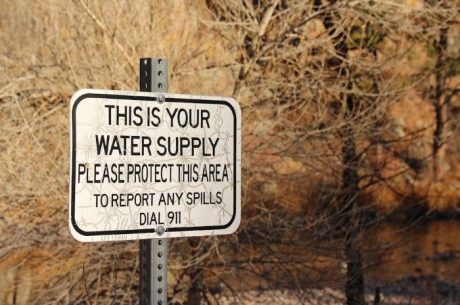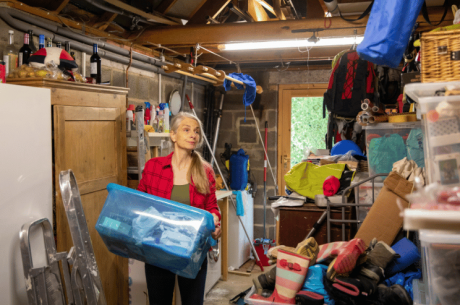To clean up sewage safely, start by protecting yourself with proper gear and making sure the area is safe. Ventilate the area, and contain the spill. Remove contaminated water, disinfect all surfaces, and discard unsalvageable items. Finally, dry the space thoroughly to prevent mold. Since sewage is a biohazard, professional help from experts like PuroClean is strongly recommended.
Ohio Sewage Backups: A Serious Property Emergency
Picture this: A heavy spring storm rolls through Southwest Ohio, pouring rain for hours. Suddenly, you notice a foul odor, and then you see it—murky water seeping into your basement. The sewer line couldn’t handle the overflow, and now contaminated water is rising, soaking into your carpet, furniture, and walls. Now you have to clean up sewage.
In our region, older plumbing systems and intense weather often lead to basement flooding and sewage backups. Sewage spills can be overwhelming and pose significant health risks. However, knowing what to do can make a huge difference.
In this guide, we’ll walk you through how to safely and successfully clean up after a sewage backup.
How to Clean Up Sewage Step By Step:
- Safety Precautions
- Assessing the Damage
- Containment and Ventilation
- Cleaning and Disinfecting
- Drying and Dehumidification
- Preventing Mold
- Repairing and Restoring
- Get Professional Help
Important Information
The methods below are sufficient for small spills and backups (contained in one small area). However, professional help is strongly recommended for all cleanup involving sewage due to the health risks involved.
Sewage Spill Safety Precautions
A sewage spill in your home or office isn’t just a nasty mess—it’s a serious health hazard. In addition to the foul odor, you’re dealing with dangerous bacteria, viruses, parasites, and even toxic gases.
Protect Yourself from Sewer Backup Biohazards
To minimize exposure to harmful pathogens found in sewage, while cleaning, always wear personal protection gear:
- Waterproof rubber boots
- Heavy-duty gloves
- Protective eyewear
- An N95 or HEPA respirator mask (a P100 respirator is recommended).
Also, follow the precautions below:
- Evacuate vulnerable individuals. For safety, keep children, pets, and anyone with compromised health out of the area until cleanup is complete.
- Sanitize thoroughly. Wash your hands with hot water and antibacterial soap after each cleanup shift, and disinfect any personal items that were in contact with contaminated areas.

Additional Sewage Cleanup Precautions
Electrical and Water Safety
- Turn off the power. If it is safe to reach the breaker box, shut off power to the affected area. Water and electricity are a dangerous combination.
- Avoid using electrical equipment in wet areas. Wait until the area is completely dry and cleared by a professional before using fans, vacuums, or other electrical appliances. Do not use wet electrical outlets.
- Turn off running water (or even your main water supply).
Structural Safety
Before starting cleanup, check the building to make sure it’s safe. Sewage water can weaken walls, floors, and structural supports. (Don’t stand on visibly damaged areas.) Basements and other low-lying areas are particularly vulnerable to structural damage from sewage backups or flooding.

Fire Safety
- Avoid igniting flames. Methane gas in sewage is highly flammable. Avoid open flames or any devices that might produce sparks in the affected area.
Food and Water Safety
If stored food has come into contact with sewage, or if sewage has backed up into the kitchen, take precautions with food and water.
- Dispose of exposed food and drinks. Discard any open or unsealed food or beverages exposed to sewage.
- Check canned food and food stored in jars. Throw out items that are leaking or have bulges.
- Use bottled or disinfected water for cooking and drinking. If the water supply is compromised, boil tap water for at least one minute before use to kill contaminants.
- Discard porous items. Throw away porous items like wooden utensils or baby bottles exposed to sewage, as they can retain bacteria.
Assessing the Sewage Backup Damage
After a sewage spill, you will need to conduct an assessment to determine the level of cleanup and restoration needed, and set you up for a smooth insurance claim.
Start by noting any standing water, which is often present during heavy rainstorms. Contaminated water can quickly compromise both health and structural integrity if left untreated. If you see standing water, contact a structural engineer or restoration expert.
Next, check the structure for cracks, warping, or shifting. Make sure to include walls and stairs. Also, examine floors and furnishings.
Determine which items can be cleaned and which need to be thrown out. Hard (non-porous) surfaces can often be disinfected, but porous materials like carpets, drywall, and upholstery tend to deeply absorb contaminants and sewage debris and may not be salvageable. (See below: Removing and Disposing of Contaminated Items).
Pro Tip: As you assess, take clear photos or videos and jot down detailed notes of all damages. This documentation is key when filing an insurance claim, helping you get coverage for cleanup and repairs.
Ventilation and Containment
Containing the damage and ensuring proper ventilation are your next steps. Start by creating a barrier around the space to prevent contaminants from spreading to other rooms.
Close interior doors. If needed, use plastic sheeting to isolate the area. Turn off your HVAC system to stop contamination from spreading through the air ducts.
Next, improve air circulation. Open windows and exterior doors to let in fresh air. Also, if it’s safe to do so, use fans. Airflow helps clear unpleasant odors and reduces gas buildup.
Containing Sewage-Contaminated Waters
- Use absorbent pads. To soak up small amounts of water, place absorbent pads (available at home improvement retailers) around the perimeter of the affected area. Use thick rags or towels in an emergency, but discard them after use. Additionally, change them out frequently to prevent the growth of bacteria or mold.
- Lay down sandbags or absorbent barriers. For larger spills, consider using sandbags or commercial absorbent barriers to prevent sewage water from spreading further into other parts of your home or office.
Cleaning and Disinfecting
Once the area is contained and ventilated, you can use a wet vac designed explicitly for biohazard or water removal. Standard vacuums are not safe for handling sewage or sewage water.
- Remember to keep using your rubber gloves, boots and other protective equipment.
- Work in manageable sections, tackling smaller areas, one at a time, to ensure thorough water removal. Frequently empty the tank to avoid overfilling and spills.
- Once finished, disinfect the vacuum thoroughly by rinsing the tank, hose, and attachments with an EPA-approved cleaning solution to eliminate any lingering bacteria and odors.
After water removal, disinfect all hard, contaminated surfaces, including floors, walls, and any non-porous items, with an EPA-approved cleaning solution. Products containing antimicrobial agents are especially effective, since they target bacteria and help prevent mold growth.
Removing and Disposing of Contaminated Items
Heavily contaminated items must be thrown out to ensure a safe and thorough cleanup. Porous materials like carpets, rugs, and upholstery (but also things like books, contaminated clothes and photos) can absorb sewage water, making them challenging to sanitize.
- Follow local disposal guidelines: Proper disposal of contaminated materials (including wastewater) helps prevent the spread of bacteria and keeps your home and community safe.
Can anything be saved after being exposed to a sewage spill?
In some cases, personal items (such as photos and documents) and high-value items may be restored professionally, especially if they are only slightly affected by the sewer backup and contaminated water.
Drying and Dehumidification
To restore your space and prevent mold growth, thorough drying is needed. Using professional-grade equipment, like industrial fans and dehumidifiers, ensures the area is dried to industry standards.
If you don’t have access to professional drying equipment, use these steps to dry your space:
- Use fans and dehumidifiers. Regular fans and dehumidifiers can help circulate air and reduce moisture. Use multiple fans and place a dehumidifier near the damp area.
- Open windows and doors. The improved airflow will help release moisture and odors, especially in Southwest Ohio’s spring and fall when outdoor humidity levels are lower.
- Use absorbent materials. Use towels or absorbent cloths to help soak up remaining moisture.
- Adjust the temperature. In cooler months, slightly raising your home’s heat can help speed up evaporation. Just be sure it’s safe and comfortable to do so, and never use electrical heaters in wet areas. During warmer months, lowering your air conditioning setting can help with dehumidification and moisture control.
Southwest Ohio’s naturally humid climate can make drying more challenging, so keeping humidity levels low is key.
- You might like: What Causes Sewage Backups
Preventing Mold Growth
Sewage spills add moisture and create optimal conditions for mold growth, especially during humid seasons. Here’s how to stay ahead of mold and protect your home.
- Check for mold regularly. As the area dries, check for any signs of mold. Once exposed to water, mold can start to grow within 24 to 48 hours. This is especially true in areas with high humidity.
- Look for common mold indicators like musty odors, dark spots on walls and floors, or a fuzzy, greenish-black coating on surfaces. Finding mold early means you can deal with it before it spreads.
- Use anti-microbial treatments: To help prevent mold, apply an antimicrobial solution on exposed surfaces. Look for an EPA-registered antimicrobial cleaner. Check the label to make sure the product is effective against mold, mildew, and bacteria. Follow product directions for information on how to apply and drying times.
Restoring and Repairing
Once the cleanup is complete, it’s time to focus on restoring your home:
- Repair and restore the space. Re-inspect the walls, floors, and furniture for damage. Make sure floors are completely dry. Replace carpets or other items that have soaked up water.
- Make sure the plumbing is functional. To prevent future issues, hire a licensed plumber to inspect and confirm that your sewer lines, sump pump, and drainage systems are functioning correctly. The plumber can ensure everything is in line with local building codes and help identify potential vulnerabilities that could lead to another backup.
Professional Sewage Cleanup Help
Consider working with professional restoration experts for a safe, thorough cleanup and effective prevention plan. Here’s how expert help can make a difference:
Hire local experts like PuroClean Emergency Services
In Southwest Ohio, PuroClean Emergency Services specializes in sewage backup cleanup, including flooding issues, drain backups, and overflow. Our team adheres to strict industry standards to make sure your home is fully restored and free from residual hazards caused by sewer backups.
- Insurance coverage and claims assistance: PuroClean works directly with your insurance company, making the claims process easier to navigate and helping you understand your coverage for sewage backup.
When it’s time to call a professional, call PuroClean Emergency Services (937 401-9700) for complete and compassionate sewage cleanup or other biohazard services.
Our Service Area:
We serve Ohio, from Piqua to the north, Dayton to Cincinnati, and the surrounding areas.
Sources:
CDC: Reducing Health Risks to Workers Handling Human Waste or Sewage
EPA: A Brief Guide to Mold, Moisture and Your Home
Q: What should I do when the sewer backs up into the house?
A: Immediately shut off any water sources contributing to the backup, avoid contact with the sewage, and contact a professional cleanup service as soon as possible to decrease damage and health risks.



